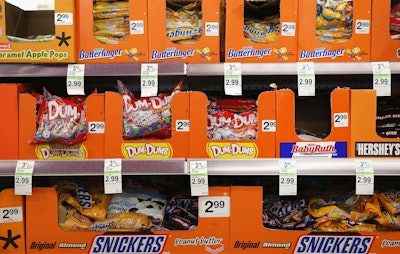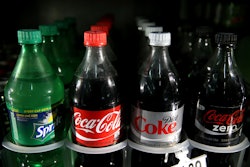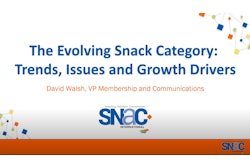The following is a transcription of an Innovation Stage presented Wednesday afternoon, November 10, during PACXK EXPO Connects. Watch the discussion including statistics and pictures here until March 31.
Hi, I'm Larry Wilson, the VP of industry affairs for the National Confectioners Association. We represent the chocolate candy and gum industry and mints in Washington, DC. We're going to talk today about sweet insights. The state of treating you'll note, we call it sweet insights. We don't call it sweet data, while you're going to see a lot of data, it's really the story behind the data that we want to share with you today. So let's just jump right in and talk about the methodology very quickly. First of all, a lot of the research here was conducted from an inaugural study that we did, commissioned by NCA conducted by 210 analytics. We looked at the surveys, consumer attitudes behaviors, we looked at an overlay with IRI. We included some insights from global data. But today we're going to talk about really the state of treating. We're going to look at what happened in 19 and through the mid year in Q3 and what's going on with the COVID and the impact that that means.
So here's our agenda at 2019 that look at the pandemic mid year. And then we also just got some data through Q3. So the world that we're looking at right here is, this is a confectionary industry that 37 billion is the all in number, but we can only really measure through the IRI that 26 billion of it. And that's where those scanners in retail measure. It's the fourth largest category, and just about everybody consumes it at 98% household penetration. Now, here's where a lot of the numbers began, but I think that the key here to take away is, we saw 2019 really strong and it was pretty consistent, and you could see that on the top line there and then you can see some of those numbers started to reverse with the pandemic. And that was the March 15th through the October 4th period. That that pandemic period is.
Also the mid year, that is the full year 2020. And you could see that all the way through what's going on in through October 4th. There we've got some strength in chocolate and candy, but we do have some big challenges relative to gum and mints. And when you think about what those challenges are, people are sheltered at home. They're not going to work. Much of those products were consumed at work or in the car or in transit, and or they were purchased in convenience stores, which many of them were not going there anymore. Now, what we're seeing is also a switch. When we look at units, we're seeing larger packs, a lot of people put in pursuance of value, they're taking less trips, so they're getting bigger packs, retailers and manufacturers are working together to provide those. And for this industry, I think it's important that we consider that because it's really about working with the manufacturers to identify the packs that are on trend, and the larger packs in the value associated with them are important.
Also, when we look at volume that's pounds for candy chocolate and got our chocolate and candy, are you take a look here and you see that volume has been softening a little bit, but it's also reflecting that some of the pricing did impact, the volume that was purchased. And this is the pricing. Look here, you'll see, on a per unit base, you see significant price gains also on a propound base. You could see how those prices are going up. But that's the bad news in that prices are going up. The good news however, is that consumers are very willing to pay, and we're seeing that in the numbers, particularly in chocolate and candy. So if you look up where consumers are, they get it. They're seeing that the prices are going up, but again, because they're looking for those products, they're are willing to pay and they are paying it. And we're seeing that in the growth.
So this is really kind of one of the money slides, if you will. So if you think about what happened in 19, and you compare that to what's going on in 2020, this is the story. It was about seasons in 19, it's now about everyday candy and we saw non chocolate candy outgrowing chocolate, but all of a sudden we've seen a reversal. Now, with chocolate and premium growing faster, we saw a lot of new items and we're going to talk about assortment as well. We saw now skew reduction, retailers are driving for efficiencies and effectiveness. We used to be about incremental, and that, that means over and above the base business right now, we're just managing that base business. And that's the story kind of over the pandemic, but no surprise that the grocery is the leading channel now versus what we were seeing before. But E-commerce, you'll see in the numbers is the star.
So when you look at what are the levers that drive the business, there's really three things. It's having more people buy, having them spend more, and having them buy more often. So we were looking pretty good on those metrics. If you look at more people buying, again, everybody was buying and I'd held pretty steady with 98%. We also had people buying more often holding steady at about 35 times a year, but they were also spending more. And that was a good story for 2019, but we'd seen some changes now, when we think about what's happening with COVID-19 and here you see a year to date comparison, what's going on, and you see a little lower household penetration, you see that the frequency on the right side has gone from 17 to 16, but they are spending more, and that's the good news.
So they're shopping less spending more, and spending more on confections, which is a really positive thing. We look at channels and this is panel data from IRI, and essentially what we're seeing here, if you look at the highlighted, the bolded numbers there, you're going to see that there's less trips on the right in grocery drug mass of N, but you can see the spending is up on a spending per trip basis. And because people are sheltered at home, they're really trying to be efficient when they go shopping. And then instead of shopping two or three or four stores, now there may be shopping one, and you can see some of those channels that they are shopping, where they're spending their money, and that's important. E-commerce number. We're going to talk about that in a moment.
We're going to look at the channels in a little more depth as well. But so what's going on behind those trends, and that's really a look at the consumer. And essentially, when we look at non chocolate and chocolate, what are they spending on now? And you could see boomers, they were big on chocolate. They were spending about $40 a year, and yet when you look at the younger generations, you can see that the spending for millennials and gen X is you're seeing they're higher. And so it's important when you think about planning for the future and working with the manufacturers to address those generations, that you address those growing segments for those populations. And one of the things about those millennials and gen Xs is, they're all about experience. So when you think about things like packaging and merchandising, that's a big deal for those people because they want to be inspired.
They're less loyal, and they love the inspiration that we can provide through packaging, new items and innovation. So when we look also where the growth is going to come from, you can see it's going to be about the millennials and the gen Xs. And so really understanding kind of the current spending of the generation now, but also planning for the future and bringing that inspiration, and having those offerings to engage those younger audiences in the segment is going to be really important. And that's why we look at this data, because this is kind of where the puck is going, if you will. On millennials, they're driving the non chocolate, we mentioned, and you could see what those numbers are in terms of where the growth is, and it's really about gen two and millennials, as I mentioned for the non chocolate.
But here's something that's kind of interesting too, is when you think about where the trips are, you could see also the dollars are in the millennials and the gen Xs, because as you would expect that the boomers and seniors are scaling down smaller households, etc, but you could see where that spending is going. And so that's the good news. But then when we look at what's going on here from the pandemic, the millennials are the hardest hit generation, and you could see, they were furloughed. They had above average rates cooking... I'm sorry, of eating away from home, now they're cooking at home. They used to go after specialty stores, now they're really focused on grocery e-commerce. They're deeply engaged and will continue to be, and we're going to see that even more. And they're also now starting to have those kids. So it's really about understanding that millennial group and what they are interested in and preparing the items for those consumers.
So why do we even look at assortment, because it's really important? What we find is that assortment matters both for planned and unplanned purchases for this category. And so it's a big reason why a lot of shoppers shop the category because they love inspiration. They love new, they love that emotional connection they get, and the excitement that it brings to the shopping experience. And you could see though, what's happened though with a skew optimization that we've referred to earlier, we've seen declines in those items. And we've seen average number of items down.
You could see what that looks like by segment, and that is concerning because it is assortment, and variety is so important to this category. So as we think about how do we come back from the pandemic, plan now work with manufacturers. Manufacturers work with the suppliers to create those items that drive inspiration and innovation, either in packaging, in item and offering. And you could see these are the numbers, more numbers in. You need to know, but what is important here is, there are a lot of skews and it was a big driver in what was happening really across all of those segments in 2019. And this reversal of skew optimization is of concern. So as we're planning beyond the pandemic, plan to address assortment and drive innovation, because this is what we're hearing from our own research.
People are looking for variety and types of brands in both the everyday items on the left there, but also in the seasonal items. So again, variety is critically important, even though right now, temporarily, we're dealing with skew optimization, it's critically important that we get out in front of this and do our planning now to drive new and innovative items. And so when we think about why people are buying online, this is what, one of the things that is driving people online. So those folks that are looking to have their shoppers in their stores, right now over 90% of candy is sold in the stores, but we're seeing huge gains in e-commerce. And again, assortment is one of the leading reasons because they can't find it. So by skew optimizing, if they can't find it, they may go online and want to try to keep that bricks and mortar moving.
Also, when we look at what's going on with millennials, these are the things that are motivating to them, price and sales, promotion, and brand and mood. You see, mood is really important to them. As I mentioned, they look for inspiration and then look at those promotions and that those new items that can help reduce the focus on price. It's important to consider that. Then also, when you look at what's going on with that group, you're seeing sales promotion and in store. Again, it's that inspiration. And there's a lot of work that the manufacturers and suppliers do and can do and will want to do, to really inspire those shoppers to come back to the category, and to have experiences with those new items and to drive purchase, particularly in some of those segments like gum and mints that are significantly hampered as we saw before.
We're seeing in terms of how people are shopping, we're seeing fewer and shorter trips, and this is what the numbers look like. You get about 20 minutes is what most people are spending in the store now, and if you see what's going on in the lines there, you could see how that is changing. And it's really about get in quickly and solve for your shopping trip and get out. It's not the shopping experience it was once, when we're all social distancing and trying to drive efficiency. So when we look at the everyday aisle, this is kind of what we heard. And if you look on the right, these are the research findings. We've done this twice in 2015, they said, "Okay. It's okay." About half said, "It's okay." But it's nothing really memorable. Whether saying about the same thing in 2020, and it's really no different than the bread aisle. The good news is, it's a little better in that, but still, this is an opportunity to really that... we've got a category here that has a lot of experience, sensory experiences that could be brought to life in this category.
And when we ask shoppers, these are the kinds of things that they want. They want it to feel like wonderful yummies. They want to have visually appealing. They want it well-organized, they want fun and whimsical. These are the kinds of things that, as you're thinking about working manufacturers and suppliers that you want to address in your planning, and to provide those retailers those things that their shoppers are looking for.
And here are some kind of fun things that are being done out there. You could see some really cool experiences that are drawing people into the aisle, drawing them to the end caps, and really bringing that experience, that candy store experience, there's a store within a store on a right there. So when we think about what, again, summarizing those themes, variety is important. They do like sampling. They want obviously favorable pricing, they want to experience and fun and exciting environment. This personalization is a big deal now, and they also want ideas, but the ones that are highlighted there are the ones that in the pandemic mode are a little more challenging. We're going to have to be careful how we sample, and even the personalization and customization. But it could be an opportunity, for example, with bulk, you can take those items that they may have been serving in bulk and make some unique and fun packaging so that they can personalize it as they were when they were buying bulk.
The other thing relative to packaging, you look at standup bags and boxes, you see how they pop off the shelf, it improves that overall experiences much better than lay down bags. You see those end caps that celebrate the candy shop experience. The other thing is this, as I mentioned, the adopting this bulk to kind of this world of COVID now, and we did do some protocols on bulk to manage that safely, and you want to take a look on the NCA website and you can find those. Also, exquisite merchandising. There's that experience that just draws you in, look at the cross-merchandising, you've got flowers and candy and some we'll do things like greeting cards, etc, but also lighting on the right. You can see how it, again, it draws people to those Isles, make some pop better than kind of this laid down better than a bread aisle. This really makes that whole aisle pop.
Why do we talk about seasons in everyday? It's really important because, when you look at what's going on and what was happening back in 2019, we were modest growth in everyday on the left there about just under 2%, but look at what seasons we're doing in dollars, 6% growth. But look at the reversal that we've seen, when we think about what's happening with seasonal, it's now a lot about what's happening every day. So when we talked earlier about what's going on in the aisle and why that's important, again, much of the product is sold in the aisle. So making it out an aisle experience is really important. Number 1 and number 2, how do we Gael up that seasonal experience? And this is where the manufacturers and suppliers can really work together because, that variety and experience is something that everybody's looking for.
So seasons, this is a little bit... may not be surprising the most, but the degree of surprise is considerable. If you look at the little dotted line there in green, that's all items in a grocery store, but when you look at candy, what's happening in the pops you get in Valentine's, Easter, Halloween, and holidays, look at the incrementality that represents. And that's one of the reasons that's a huge opportunity to celebrate. So getting those celebrations back, and we're doing a lot of good work, Halloween is happening and we've worked with the industry to help. And the manufacturers are working with retailers in providing new and interesting and creative ways to bring Halloween. But there was another area that was really a gap when you see the scale of those seasons during the summer. And we heard that from retailers and we had a program, we called national candy month.
Most of that was where we were talking and influencing inside the Beltway and key influencers and nutritionists and so on, about how candy can be a treat and a happy and balanced lifestyle. But what we heard from retailers is, wow, what an opportunity for merchandising. So they wanted to give it a shot. We did, and we had a pilot program and it was huge. There were three retailers Corborn's up in Minneapolis, travel centers, and also Hy-Vee, and you could see, wow, they did it big, they brought in store theater, they made this promotion really huge. And so this can become that fifth season, but wow, there are a lot of ways that we can adapt, and this is some of the things that the retailers have been doing, I should say, to adapt to the COVID, and you could see, they're putting it in their messaging. They're putting it out there and being unapologetic about candy and saying, "This is an opportunity to really enjoy it." And you can see a celebration for the summer and for the All-America red, white, and blue celebrations, and bringing those to life in store.
But look at all the other opportunities. When you think about the cards, and this was actually borrowed from Hallmark, look at all of these opportunities that could involve confections and in support of that emotional wellbeing. And then when you look at how is the category purchase right now? This is what we saw in 2019, and you could see there's a lot. They add up to way more than a 100%, because what it says is, shoppers shopped in a lot of different channels. But what we're seeing now is a concentration in channels, and we're seeing grocery is clearly the winner. And we're like, look at that data through Q3, you could see the huge games in overall 7.5%. Look at every day, almost 15% growth. But again, seasons, even in grocery where we're seeing the largest growth, seasons are challenged there. And then when we looked at drug, they were recovering really nicely because they'd been challenged.
But look at what happened since the COVID hit. It's really impacting and a lot of numbers that opportunity to turn around here. And then we're seeing in C stores, we're seeing a slight turnaround that had been significant declines early during the pandemic, but it is coming back. As people get back out on the road, shop those convenience stores and purchase candy, gum and mint. And then this is whole ... the growth that we were seeing across the E-commerce World. And here we're already seeing this at 1.5 billion growth in 2019, but wow, this is [inaudible 00:21:05] from IRI, a recent presentation they made, and look at the level of growth there on the left, 104% that was in their early COVID period. And then the green is the later COVID period. But look at those triple digits growth in the E-commerce [inaudible 00:21:24] that is a lower, a very low percentage right now it's about, 110%, but it's still huge growth, and this behavior driven here, as you see by click and collect is going to continue. There's a lot of other channels and here's what else is going on.
These are some of those channels that were in that 37 billion that were not included in the 26 billion that we'll refer to earlier. But some of these have been significantly challenged because of COVID, and many of them have even been closed and some of them are coming back slowly. So as the business comes back, so two of these channels, but giving attention to these channels is going to be important and giving attention to this where consumers are, this is a challenging time emotionally for a lot of people, and we've done a lot of research around emotional wellbeing. And what we find is, people believe emotional wellbeing is as important as physical wellbeing, and wow, in the COVID period you hear, and you're reading a lot about what's going on with that. And when we ask people, how treats relate to that in our own research, 72, nearly three quarters say, "Wow, confections does play well and help in that emotional wellbeing." And you can see some of the things that they commented on there on the right-hand side of that chart.
And even more now, while people are sheltered at home, it's critically important to leverage that emotional wellbeing that this category can provide, and also the authenticity of this category. We are a treat, and it's only enjoyed two to three times a month, I'm sorry, two or three times a week, and people get the fact that there's sugar in candy, and this is what our research finds. And in every research initiative we do, we find that it accounts for only about 2% of the annual calories. So it's really about emotional wellbeing, and this is what they say, these are the words they use when they talk about this category. Nothing new necessarily, but it does suggest that they understand that it's a treat, and they like to share, and they like to gift as well. And again, those emotional moments, especially now that we're sheltered at home, some real good opportunities to leverage and to bring those products and packaging and innovations that serve into that.
And then relative to packaging, we got some information here from global data, and I want to just share a couple of slides here. This is what we found. And essentially, you see flexible packaging is driving it, and you can see on the right there, some of those trends and where they're going. This was data that was published in 2019, but you can also see what those trends are, and so it's really understanding where the industry is going, and you can see it projects out to 2023. So again, be where the puck is going to go, be where the consumers are going to go, be with the kinds of products that they're responding to, but also look at some of those package types. And these are some of the data, and you will get a copy of this.
So you'll be able to look at that in detail, because there's a lot of information on there. But essentially, it's responding to the types of packaging. Those standup bags, as an example, while they're still a relatively small percent is significant opportunity to bring a better experience at retail, but also consider packaging as it relates to E-commerce, and it's really important to keep that in mind. And so the other thing that we'll talk about as we begin closing out of here is really mega trends. Again, this idea of being where the consumer is going to be, what are really the mega trends that are happening. And essentially what we're seeing is, well-being, and I mentioned Candy's role in wellbeing. And I said that it was also about emotional wellbeing, but there's also a physical wellbeing that people look for.
And that's where Front of pack labeling comes in. That's being authentic, being transparent, putting that information up front, and that's what consumers say they want. They say it's beneficial, and we want to be responsive to that. And then also the industry is responding. We said that half of the items at the checkout are going to be 200 calories or less by 2022, 90% of the volume is going to have Front of pack labeling. And also we're doing consumer education and support, and if you check out the www.always a treat.com, you'll see there some really good information that speaks to how the industry is working with you. A lot of tips, a lot of insights relative to enjoying confection while managing the sugar intake.
The second is social responsibility. Wow. We've heard a lot about that since this summer. No new news here. And it's probably, this was data that was from early in 2020, prior to some of the summer events. And you can say that it's going to be more and more impactful. Also sustainability, again, when we think about packaging and products that is more important now than ever, and the gen Zs and millennials, that really matters. They're one and a half times more likely to about that. And then also transparency and traceability. People want a transparent, they want to know what they're eating, where it came from and so on. So I'm just going to close out here with some final thoughts. If you think about how do we address, what does this mean going forward and how manufacturers and suppliers can work together? It's really addressing the new realities. It's understanding what happened in 19, but recognizing it's a new world that we have, but emotional wellbeing plays very well into this world, both in every day and seasonal, but seasonal is a huge opportunity around the big four seasons.
And then some of those other seasons that I shared with you earlier, that you can take advantage of and even make up some of your own and leverage candy month. We're going to go a bigger, and there's going to be more information coming out in the next several months regarding how you can celebrate national candy month next June. Also, consider the channel trends, the mega trends, the packaging trends, as we think about working with product development and packaging innovations. And then also, we do know that those ingredient trends around claims will drive growth. They move away from price, and those things like brand and mood are really important, but we also want to be mindful of what some of those millennials and gen Zs are looking for.
And then lastly, it's really being environmentally responsible. And that's where a lot of the packaging comes in because people are looking more and more, they're going to be legislating things, but also they're really forward thinking companies. They are the ones that are getting out in front of this with flexible packaging and sustainable packaging. And it is going to be a growing trend. And our industry will be continuing to look at it as the rest of CPG is looking at it.
So with that, I just want to close out and thank you. And it's an honor to speak to this group. I do very excited about an opportunity when we can have the suppliers and the manufacturers working together for this industry. We do appreciate all the support that both the suppliers and the manufacturers in this industry offer up. And we hope that some of this information has been valuable to you. And if you'd like more information, you want to have one contacts, there's our information. Please reach out to either to me or to the researcher. We're happy to help you out any way we can. So with that, thank you. And we look forward to seeing you soon, take care.






















